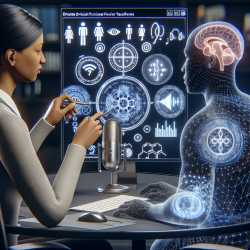Introduction
In the ever-evolving field of speech-language pathology, practitioners are constantly seeking innovative methods to enhance therapeutic outcomes. A recent study titled "Implementation of Quantum and Classical Discrete Fractional Fourier Transforms" (Weimann et al., 2016) presents groundbreaking research that could potentially revolutionize the way we approach data analysis and signal processing in speech therapy.
Understanding the Research
The research conducted by Weimann et al. (2016) explores the implementation of discrete fractional Fourier transforms (DFrFT) in both classical and quantum optical systems. This advanced mathematical tool extends the capabilities of the traditional Fourier transform by allowing for fractional orders, thus providing a more nuanced analysis of wave functions.
The study demonstrates the practical application of DFrFTs in integrated quantum computation, showcasing their versatility and potential to be adapted across various fields, including speech-language pathology. By leveraging the DFrFT, practitioners can achieve a more detailed understanding of complex speech signals, ultimately leading to more precise interventions.
Applications in Speech-Language Pathology
In the context of speech-language pathology, the ability to analyze speech signals with greater accuracy can significantly impact the diagnosis and treatment of speech disorders. Here are a few ways DFrFTs could be applied:
- Enhanced Signal Processing: By utilizing DFrFTs, therapists can better isolate and analyze specific components of speech signals, leading to more accurate assessments.
- Improved Speech Recognition: The advanced capabilities of DFrFTs can enhance speech recognition software, making it more effective in identifying speech patterns and anomalies.
- Data-Driven Interventions: With a deeper understanding of speech signal dynamics, therapists can tailor interventions based on precise data, improving therapeutic outcomes for children.
Encouraging Further Research
While the study by Weimann et al. (2016) provides a solid foundation, further research is necessary to fully explore the potential applications of DFrFTs in speech-language pathology. Practitioners are encouraged to delve into this innovative approach, conducting studies that apply DFrFTs to real-world therapeutic scenarios.
Collaboration between speech-language pathologists and researchers in the fields of quantum computing and signal processing could lead to groundbreaking advancements in the field. By embracing this interdisciplinary approach, we can continue to push the boundaries of what is possible in speech therapy.
Conclusion
The implementation of quantum and classical discrete fractional Fourier transforms represents a significant advancement in the analysis of complex signals. For speech-language pathologists, this research offers a promising avenue for enhancing therapeutic outcomes through data-driven decision-making and precise signal analysis.
To read the original research paper, please follow this link: Implementation of quantum and classical discrete fractional Fourier transforms.










